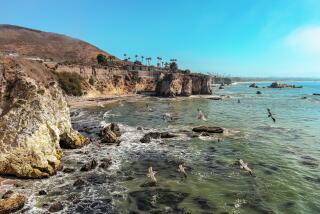The Restoration Victory Tour
- Share via
Eileen Murphy navigates the dirt trails through the Bolsa Chica mesa and wetlands with a bounce in her step and a smile on her face. She says hello to everyone she passes, expounds on the evils of development to those who will listen and all the while oohs and ahs over the great blue herons and egrets as if she’s seeing them for the first time.
But Murphy has been traversing these wetlands for years. It’s just that these days, she has a lot to smile about. Last week, the California Coastal Commission unanimously approved a $100-million plan to restore the wetlands to their natural state--something environmentalists like Murphy have been fighting to achieve for decades.
Murphy and about 20 people toting cameras, binoculars and bird guides joined Sunday’s tour led by Marinka Horack, one of the Bolsa Chica Land Trust organizers. She gave the group a primer on endangered species and marine life and a walk by the Newport-Inglewood earthquake fault line, the site of the old Bolsa Chica Gun Clubhouse and World War II gun mounts.
“I live so close and it’s such a pristine area,” said Jeff Lebow, 53, of Huntington Beach. “I want to know about it. I’ve seen it. I’ve walked through it, but sometimes I don’t know what I’m looking at.”
The wetlands restoration plan, which will return ocean tides to the 1,200-acre expanse of salt marsh, mudflats, pools and oil fields, is the most expensive wetlands recovery effort in state history.
Despite the news, Murphy, 85, a founding member of the Bolsa Chica Land Trust, said Sunday she won’t rest easy until the work is done.
“I just think it’s the most fabulous place in the world,” said Murphy, who hikes with the speed of someone half her age. “I’d be heartsick if they build on it. That’s why we can’t give up because we’ve come so far.”
About 5,700 homes and a marina were once slated to be built, but that number has since dwindled to 387 homes planned for the mesa. In 1997, the state saved the wetlands from development by buying 880 acres for $25 million. The state had previously bought a smaller parcel.
Members of Bolsa Chica Land Trust, a group dedicated to preserving the wetlands ecosystem, offer free walking tours on the third Sunday of each month. They say it helps educate people about the rich landscape, endangered species and history hidden on 1,700 acres off Pacific Coast Highway.
Lebow, who works on economic development for Southern California Edison, said the wetlands are a unique feature that should be developed for eco-tourism.
“For us to build on it and make another residential community in the long run doesn’t make economic sense,” he said.
On Sunday’s tour, the group passed joggers, families and a biology class out bird-watching. One man held his daughter’s hand as they walked through the wetlands.
“It’s like a natural Disneyland,” he told her. “A Disneyland for birds.”
Seventeen homes have already been built on the mesa, and Murphy said digging is underway. Tractors and other heavy equipment are visible behind the chain-link fence that separates public and private land.
Environmentalists and Native Americans say the construction site, known as ORA 83, may be home to at least 25 burial sites where remains and cogged stone artifacts have been unearthed.
“It’s hard to believe people would think of destroying what we do have,” said Donnie Haigh, 56, of Long Beach. “The irony strikes me that people want to live so near the natural beauty that they destroy it.”
More to Read
Sign up for The Wild
We’ll help you find the best places to hike, bike and run, as well as the perfect silent spots for meditation and yoga.
You may occasionally receive promotional content from the Los Angeles Times.







